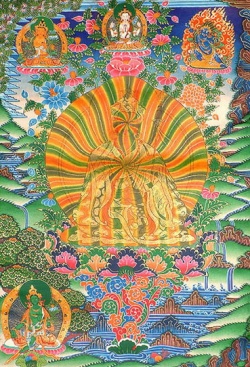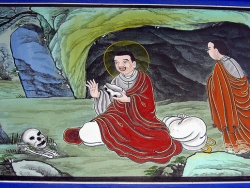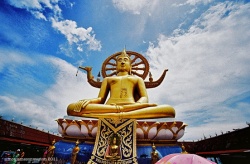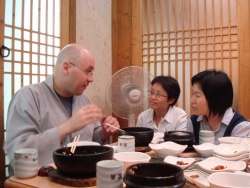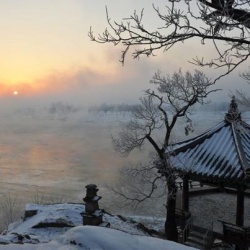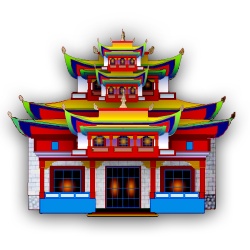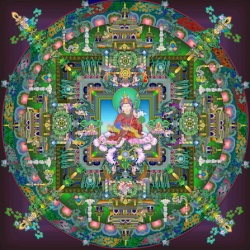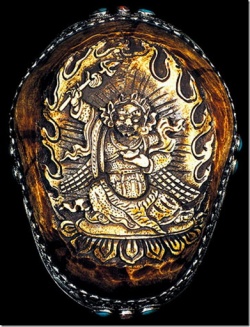Nothing Better than Long Term Retreat
On Sausal Creek
From Sausal Creek to other universes and back. The story of the meanderings of an Oakland Dharma practitioner, her periodic seclusions in the riparian corridor of this urban creek, and wanderings both mental and actual.
Fulfilling the Bodhisattva Vow by Staying Put
One view from my practice tent in my backyard.
You should take everything I say with a grain of salt, because I am not a teacher of any kind, and I lack realization. I’m just rambling about what is on my mind.
In Mahayana Buddhism, including Vajrayana, we take a vow to attain liberation for the benefit of beings so that we can place all beings in that state. Technically, Awakened Ones can’t wave their magic wand and grant everyone enlightenment, like a fairy princess. If they could have, they would have. They lead and inspire, and are a source of blessings for those who have faith in them. I have faith in that, because I have been lead and inspired by awakened beings for many years — actual flesh and blood teachers. I have faith, too, than there are Sambogakaya emanations also helping me, but I can’t see them as an ordinary person.
Based on my faith in these things, which cannot be proven, I want to apply myself to awakening. I don’t know if it will happen in this life or afterwards.
I am a very inattentive person, with many interests. Left to my own impulses, I would start several hobbies every month, and travel a lot. So, I have to be mindful of these tendencies, and remind myself of that my primary goal is to awaken. I remember the advice of my lamas, which has always been to focus on practice, and within that, to focus on the daily continuity of the core practices they recommended for me.
I have built in interruptions in my daily practice few times a year, because I need to help out our Dharma centers, to the best of my limited ability. I don’t enjoy group practices much at this stage in my life, but I’ve been asked to help, so I do them for the benefit of sentient beings and the Dharma. This takes me away from my house, usually, and reduces or eliminates my personal practice time. I’m relieved to get home afterwards, honestly, and resume the continuity. No one is ever going to affirm that we have continuous practice, unless we are in formal retreat. Right? Even lamas need help with their projects. I have more than enough teachers. Honestly, I stay away from new teachers, because projects ensue as soon as you affiliate closely. And rightly so, there is a lot that needs doing.
As much as I would like to do pilgrimage to Asia, I have never been. I’d also like to go on trips to beautiful, tropical locales. I come close to signing up, and then I think about my need to practice in solitude each day, with the right kind of physical set up. How is that going to happen on a group trip? In other words, I remember my Bodhisattva vow. Someday I’ll probably go, but it will have to be imperative.
One Continuous White Water Thrill
Twenty years ago or so, I saw a wonderful movie by a canoe-ist from Minnesota. He was an older man who had cleaved the waterways of Northern Minnesota for decades, in a wooden canoe. For these guys, the peak experiences are paddling whitewater.
At one point in the movie, he showed himself canoeing through extreme rapids for a very long time. In the narration he explained that, in reality, these were many whitewater experiences spliced together so it looks like a long uninterrupted thrill ride. Each rapid shoot was actually a brief experience, and most of his canoe trips were uneventful. He pointed out that seeing wildlife by the streams and rivers was actually quite rare, as well — but, of course, he featured the wildlife he was able to film in the movie.
That’s the way in-depth meditation is for me. My last blissful experience was a positive dream I have a few years ago. I notice that the spiritual autobiographies of the great meditators of the Nyingma tradition, the peak experiences are reported, but there are gaps of years that are simply omitted. Of course, there are exceptions, most notably, Dudjom Lingpa or Mingyer Dorje, who were constantly awash with visionary experiences. My hunch, though, is that the majority of practitioners who devote themselves primarily to meditation have a work-a-day practice, like I do. Put in the hours as best we can, like others go to a job.
When I think about dating non-practitioners, this issue comes up.
“Honey, what did you do today?”
“Well, I noticed the long tendrils of the vines near my retreat tent and thought I should cut them back. Then, I thought, ‘nah,’ and went back to meditating.”
Or, on another day, “I contemplated the real meaning of the Tibetan term ‘drakpo’ and wondered whether all drakpo activity is liberation, or whether other forceful or subjugating enlightened activity is drakpo. When people call lamas ‘wrathful’, is that doctrinally accurate? Then, I went and got a peach from the kitchen, and ate it over the sink. I noted that it has rose flavored overtones.”
“How was your day, honey?”
Oh my goodness, how could I put anyone through that level of non-activity and obscure contemplation on traditional Tibetan literature?
The Teacher, the Text and the Inner Teacher
A great old Tibetan lama used to repeat an old Tibetan saying, that went something like, “first you rely on the lama, then you rely on the texts, and you rely on your inner lama.” This is one of the many things he would say that would baffle me.
Now, on the face of it, that does not seem like a weird thing to say. Why did it baffled me? Because this lama was the epitome of someone who relied on his teacher throughout his entire life. Devotion to his teachers was his middle name. At the same time, he was also the epitome of someone who relied on texts. He read Dzogchen texts continuously. He relied on the Lonchenpa’s Cho Ying Dzod (Precious Treasury of the Basic Space of Phenomena) so heavily, that I believe one could “read” him, and it wasn’t any different than reading that book. I’m sure he would have said the same about his teachers. I certainly would.
Scenes from the movie Fahrenheit 451 pop in to my mind’s eye when I write that. People strolling slowly about, alone, talking out loud—continually refreshing their remembrance of banned books they have memorized. It wasn’t like that!
On the other hand, in some way, perhaps it was. The guys from his home center in southern Tibet, who trained directly under tutelage of one of the greatest lamas of the 20th century, are gone now. It is as though the scent of that rich tradition permeated him, and was still exuding from him when he came here to the U.S., and was commanded to teach.
So, we could read him as a “book” of the tradition, embodying it’s powerful methods for training students in various ways according to their individual capacity, and the essential meaning of Dzogchen.
So, there you have it, the third element. He came to rely on his “inner lama,” that wisdom that embued him, and was so palpable.
He moved from directly serving his lama for decades, to living at some distance, to then being asked to teach himself and moving to another country. When he visit his lama he would bring focused questions, clarifying difficulty points in a text, or key points of his to train others.
So, it seems to be a matter of subtle shifting degrees of reliance, from teacher, to texts, to inner wisdom.
Here’s a recommendation. I highly recommend the movie Amongst White Clouds. It’s from a Chinese tradition of Buddhist hermits, but it reflects my experience as an in-depth (ha!) practitioner better than any movie about Tibetan Buddhism. In it, you can see practitioners at these various stages—a group retreat in which students received close guidance from an old teacher, a few hermits who relied on the great texts of Chan, and a great old practitioner who had internalized all that.
Today, I brought my period of being a hermit to a close, rather unexpectedly. “My” Dharma center, Pema Osel Ling, contacted me, and needs my help with the annual summer retreat. It’s not that I have any great skill set, far from it. But, I can color dry white rice yellow, red and black with the best of them, and this is the kind of thing I'll be used for. So, in keeping with Lama Tharchin Rinpoche’s wishes that we all look after the center after he is gone, I did the procedure to dissolve the intense protective energy around my urban enclave. Then I had a party, all by my lonesome.
In the process, many vivid memories popped up of advice I’ve been given by my fellow practitioners and lamas. I felt sad, and didn’t know if I could bring myself to end my peaceful existence here (way earlier than I had planned). I recalled advice my friend Rinchen gave me when I went in to three year retreat. He recommended I say out loud to myself when times were rough: “Yudron, you can do this.” And so I did. It’s an amazingly powerful statement.
Lama Tharchin Rinpoche used to counsel me like that when I was having a hard time, and my mind turned negative. “Say to yourself, ‘Yudron…” What followed was a list of all the aspects of the good fortune I had. Have you ever read The Power of Positive Thinking, by Norman Vincent Peale? It was an early progenitor of the self-help book genre. I read some of it in a doctor’s waiting room long ago. Rinpoche was kinda like that. Of course, Buddhists are constantly aware of the reality of sickness, old age and death, so it has a slightly different flavor. For me, one of the main trainings in long group retreat was vey basic—how to work with your mind without going negative, when all sorts of difficult things are going on around you. Going negative usually entails coming down on someone. That person is bad, bad, bad.
Today, I was aware that my mind could go negative. Since there is only one person here, I didn’t have anyone to project my disappointment on to and make into an enemy. Instead, thoughts of my own past fuck ups came up. Specifically, the many times I blew it in my relationship with Lama Tharchin Rinpoche, who I honestly loved more than anyone in the world. My friend Gail Sher wrote a book called One Continuous Mistake. The more I strove to be a good student, the more continuous my mistakes were. There is an old adage—did it come from Chogyam Trungpa Rinpoche?—that the lama mirrors your neuroses. Well, ain’t that the damn truth!
When I started to sink, I brought to mind what Dungse Thinley Norbu Rinpoche said to me in a kata line once. He told me that when I dwell on my obscurations or defilements, I should think about Vajrasattva and Guru Rinpoche inseparable, instead. [For those who aren’t in our tradition, these are the symbolic representations of complete purity, and the guiding principle, as deities.] So, I did think about them for a moment, and felt better.
Today, I also remembered many instructions on the technicalities of ritual from my two retreat masters. There were some things I couldn’t remember, as well, but I did my best. By the time I finished, I felt my reservations about ending my solitude were resolved, and blessings were present—as they are for anyone who practices with good heart.
The lessons go on, in the absence of the physical presence of wisdom lamas, or the physical presence of my fellow practitioners.
I don’t post on my blog while I am in retreat. So, there are gaps. Nowadays, I have hesitations about blogging at all. One is, frankly, more of our lineage lamas are using the internet these days, and they may stumble on this obscure blog. I love them, and don’t want to displease their wisdom minds.
In Tibetan culture, half-baked people like me did not traditionally write anything about Dharma—even as tangentially as I am doing now. For starters, there was no public school system, so most people were illiterate. But, also, in a Buddhist society the written word of the Dharma is holy. People respect the depth of knowledge and realization that is necessary to write about it in a way that is both accurate and helpful. From that perspective, folks like me, who are not teachers, do not have realization, and are generally ignorant, should remain silent.
On the other hand, my life is dedicated to the Buddhadharma, and I am a writer by nature. So blogging is natural to me. My sojourn as a practitioner—and soon-to-be inspirational writer for teens—has it’s interesting dimensions, thrills and spills. So, I’ll press forward, and try to write responsibly.
The wife of the mahasiddha Saraha, one of the greats from ancient India, cooked some radish stew. She did not have time to serve it to Saraha before he went into a meditative state from which he didn’t emerge for twelve years.
When he regained normal consciousness:
“…he asked his wife for the plate of stew… She was upset by the request and questioned him, asking why after twelve years of meditation was he still full of desire for the stew. He was embarrassed and said they should move to the mountains so as to be even more isolated in his meditation and she retorted that it was not necessary for them to move. She explained to him that the greatest solitude comes when one is free from conceptual thought as well as the preconceptions and prejudices of an inflexible and narrow mind. Saraha was inspired by his wife's words and continued his meditation with the sole intention of freeing his mind from conceptual thinking. He began to experience all things as space, seeing the world in its natural state.”
[The quote comes from the Himalayan Art website, but sounds like the translator Keith Dowman.]
This is a famous story. When I first heard it twenty years ago, I had no clue about what it meant. Now, I know that practitioners of Mahamudra don’t strive for semi-comatose meditative states. I’m not saying I am a practitioner of Mahamudra, or anything so exalted. I’m not. But, I do take his consort’s advice seriously and aspire to do as she advised.
Today I would like to start talking about the benefits of a retreat centered lifestyle for serious Buddhist practitioners. First, I will address the ways that people have attained realization in recent history.
Among the favorite reading materials of yogis and yoginis of the Nyingma tradition are the biographies of the great, realized, lamas of Tibet. We read them in order to model ourselves after them. I have a particular interest in the 20th century adepts, because they are closer in time to my life, and a few are still alive. Many of their students are alive.
There is one catch. These are often reincarnate masters who have a lot of past life accomplishment to draw on. It is sometimes hard for me to know, as an ordinary person, how to model myself after someone who had tremendous accomplishment in childhood, or even infancy. I believe the stories, because I have personally met lamas like that. I don’t understand Buddhists who are super skeptical, but that is a whole ‘nother topic.
As I was starting to write this, I looked back through a bunch short bios on these 20th century people in the same tradition as me who had the experience of realization . There were a few things I noticed. Some reincarnate lamas gained realization while merely receiving teachings on the great Dzogchen texts, such as the Yeshe Lama, or during a one-on-one experience with their lama of being introduced to the nature of their mind via a variety of formal and informal means. As an example of informal means, one 20th century lama gained realization exactly how Naropa did; he was beat up by his lama with a shoe! This was one of the early Pema Norbus, the one who lived from 1887 to 1932.
I also noticed that most of these great lamas spent seven or more years studying, and also serving, their lamas. Some gained realization in that kind of intensive work-study-practice environment. Something must have rubbed off! This is one way to gain realization.
I also noticed that those 20th century teachers who did not 'wake up' in this kind of lifestyle (and some who did) went on to do intensive retreat practice. The biographies were sometimes short on specifics about how long and under what conditions they undertook retreat, but generally they spent between 3 and 22 years in secluded retreat.
These great figures did a lot of deity approach and accomplishment practices (nyen drups) “of the three roots.” In our Nyingma tradition, that means they did practices of the Lama category (Guru Rinpoche, Vajrasattva, or Longchenpa usually), the yidam category (such as Vajrakilaya, Manjushri, or Yamantaka), and the dakini category (Yeshe Tsogyal, Tara, etc.) Some lamas really did a lot of these retreats, which take a specific period of time (such as one, three, or six months) or the repetition of a certain number of mantras. Lamas like Dilgo Khyentse Rinpoche, Jamyang Khyentse Chokyi Lodro, and my own less-famous lama, Tharchin Rinpoche, did complete nyendrups on dozens of deities.
For practitioners of that caliber, there are many wonderful things that happen in those retreats, such as phurbas levitating, beams of light emanating from ritual objects, or a tea offering catching fire. For people of my caliber, we are lucky to have a good dream. Sometimes nothing positive seems to happen.
Quite a few of these lamas also did retreat on the core practices of the Great Perfection itself for several years. Not too many of these Nyingma biographies mention a lot of tsalung practice, but there were certainly famous lamas, such as Shakya Shri, who were greatly accomplished in that arena.
It is assumed that every serious practitioner, had miserable experiences in retreat as well. Jamgon Kongtrul, for example, very franly discusses his illnesses and difficult experiences in retreat in his autobiography. The point of having supervision by an experienced lama when one is doing long term retreat is to avoid getting carried away by positive experiences, or freaked out by negative experiences. Also, one needs instruction about how to potentially turn experiences into realization.
For me, while I am not a very good meditator (or perhaps because of it) there is delight at the thought of undertaking a new practice, or a new approach to practice in the next retreat. Some people want to travel to new places, and they have their adventure that way. I have always been enchanted by the cave dwelling yogini really applying herself sincerely to the practices, and just seeing what happens. I have endless curiosity about that. Where will this take me?
It may sound cheesy, but I do take the Bodhisattva intention very seriously. There is belief there inside me in the power of enlightened yogis and yoginis to benefit the world. Something opens, and one’s wisdom and compassion completely blossom, and one becomes a beacon for the world, and one’s prayers have real power. I’ve seen that this has happened others, and I am committed (as many, many, other simple people who have taken the Bodhisattva vow are) to follow my practice through to that point. It may not happen for me in this life, but there is always an opportunity in the bardo, or beyond.
Shortly after Lama Tharchin Rinpoche’s passing, Dzongsar Khyentse Rinpoche spoke to us twice. He talked about the unlikelihood of having the opportunity to do long term retreat in the present era, and suggested we just simply generate aspirational Bodhichitta as our main practice. Khyentse Rinpoche is so brilliant. There, at Pema Osel Ling, in a sangha where 40 people have completed three year retreat over the years, a handful have finished two or more retreats (not me!), and others are in still retreat, he gives a long talk about how it is probably impossible to do so. Interesting.
Then, he uttered just a few words, a sentence fragment; “If you can, of course, there is nothing better.”
Well, there is the upshot. If you can, of course, there is nothing better. Honestly, a lot of us really can. We have the mental stability, the faith, a trusting relationship with our lamas, a stable practice, and what? A divorce? There are certainly plenty of those. Retirement? Plenty of those. There is even a charity or two that does fund people in a well run, traditional, three-year retreat.
If you can, there is nothing better.
At the 2013 Buddhist Geeks conference in Boulder, Colorado, Zen teacher David Loy said, and I hope I have the quote exactly right, “we must tear down the myth of traditional Buddhist cosmology.”
My initial response was a defensive one, my mind responding to this—and other similar statements—with an immediate “Who you calling ‘we,’ white boy?”
I applied the key points of my practice to my subsequent emotional upheaval, which was admittedly already brewing from two speakers who had already that day mis-characterized the core practice of my own tradition. Up front, I have to admit that my attempt to transform my own reactions to this kind of approach to the Buddhadharma into non-dual open awareness were completely unsuccessful. I made several tweets during the talk that were snarky, albeit nowhere near as snarky as I felt at the time… and I am going to continue on in that vein.
I have three objections to Mr. Loy’s statement:
The first is the “we.” The Buddhist Geeks conference is noted for being frequented by practitioners in their 20’s and 30’s. This is one of the most cool things about it. I am a white woman in my 50’s who wants to see younger people benefit from genuine Dharma. The conference attendees are largely white, and the speakers intentionally included some people of color and women (bravo!), but no Asians, as far as I could tell.
The conference speakers who made the most claims about being wise and knowledgeable enough to determine what was valuable and what was not valuable in all forms of traditional Buddhadharma the world over, and – overtly or implicitly – what should be discarded, were mostly white male baby boomers. I feel this mindset has unconscious white colonialist underpinnings. Quoting Osterhammel on Colonialism, via Wiki, “the colonizers are convinced of their own superiority and their ordained mandate to rule.”
Must Tear Down
A call to arms for Westerners to tear down traditional Buddhist beliefs has in it the implicit assumptions that we Westerners have a mandate to rule Buddhism. The overt rationale is that science trumps tradition. In this vein, Loy labeled the parts of the Dharma that he did not believe in as myths, such as “the myth of the Bodhisattva.”
Buddhist Cosmology
Western science’s study of the nature of reality and the nature of consciousness is in its infancy. The idea that anything in Buddhist cosmology can be ruled out based on science is absurd. These kinds of thoughts, that the Dharma consists of only what can be measured, come out of our own discomfort with the inherently illusory nature of the phenomena that appear in our sense fields. It is soothing to our western habit to materialize the Dharma and reject the idea that there is anything beyond what we can measure and see. The idea that “others,” i.e. Asian yogis and scholars, have a greater realization or understanding of reality is unacceptable. We must eliminate any such thought immediately!
The approach to long-term retreat in the last century or so, has emphasized a three year, three month supervised group retreat. This is a format that the highly respected 19th century teacher Jamgon Kongtrul promoted, because it fits with ancient tantric teachings about time, human physiology, and the effect of practice on our energy and nervous system. Retreats can, however, be of any length.
The danger of isolated long term personal retreats, are that one can make mistakes in practice that lead to mental and emotional health issues, or one can become puffed up by personal pride. The group three year treat format protects one against this because one is supervised, hopefully, by an experienced yogi, and also one’s interactions with one’s peers in retreat may undermine the development of arrogance and wear off one’s rough edges.
I recently heard about someone who had done many years in retreat. A friend met this person, and found this practitioner had developed an attitude of superiority towards other practitioners who were engaged in another path. This is an example of pride and dualistic thinking not being eliminated by practice, but increased instead. What a waste! Or maybe that is just my pride talking, saying “what a waste!”
Personal retreat, for some, tends to cultivate more in-depth meditation.
Retreat is suitable for some people, and not for others. Super extroverts may not be comfortable with the lack of social interaction. People with schizophrenia are, unfortunately, not suitable for long term retreat, and folks with some other mental health issues may not be. Really, the advice of a senior wisdom teacher should be sought before doing a three-month or longer retreat… and I have seen some people not do well even in one month of solitude.\
So, it is not a panacea. Obviously, there are economic issues for folks as well. There is sponsorship available for participants in respected three-year retreat facilities in the west www.tsadra.org, but getting one is not guaranteed. One may need to do personal fundraising. There are visa, language, and health issues involved in doing retreat in Asia where it is cheaper.
So, I have expressed a lot of downsides in this post. If you are thinking about retreat, I am not trying to discourage you. Next, I’ll write about some upsides.

